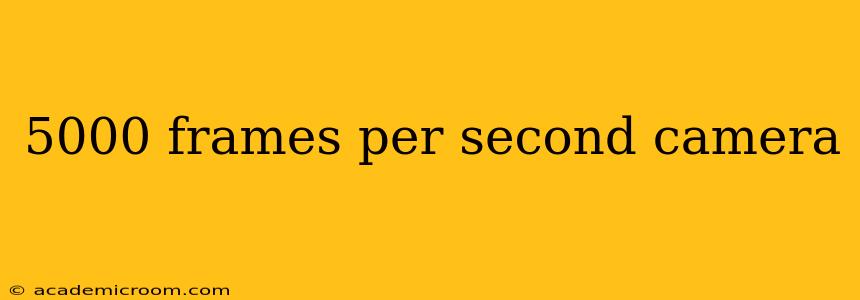The ability to capture fleeting moments with exceptional detail has captivated scientists, filmmakers, and enthusiasts alike. High-speed cameras, capable of recording thousands of frames per second (fps), unlock a world invisible to the naked eye, revealing intricate details and breathtaking slow-motion effects. But what exactly does a 5000 frames per second camera offer, and what are its applications? Let's delve into this fascinating technology.
What is a 5000 FPS Camera?
A 5000 fps camera is a specialized imaging device that can capture 5000 individual images (frames) in a single second. This dramatically increases the temporal resolution compared to standard cameras (typically 24-60 fps), allowing for extremely detailed observation and recording of high-speed events. These cameras employ sophisticated sensor technology and processing power to achieve such high frame rates. The resulting footage can then be played back at a much slower speed, revealing events that would otherwise be imperceptible.
What are the Applications of a 5000 FPS Camera?
The versatility of a 5000 fps camera is extensive, finding applications in diverse fields:
Scientific Research and Engineering
- Fluid Dynamics: Studying the behavior of liquids and gases at high speeds, such as water droplets impacting surfaces or airflow over aerodynamic shapes.
- Material Science: Analyzing material deformation under stress, revealing micro-fractures or other structural changes.
- Ballistics: Investigating projectile motion and impact phenomena with incredible precision.
- Medical Research: Observing fast biological processes, such as blood flow in capillaries or nerve impulse transmission.
Filmmaking and Visual Effects
- Slow-Motion Cinematography: Creating stunning visual effects by dramatically slowing down action sequences, enhancing the storytelling impact.
- Sports Analysis: Analyzing athletes' movements and techniques to identify areas for improvement, enhancing performance.
- Wildlife Filming: Capturing incredibly detailed footage of animal movements, especially those too rapid for the human eye.
Industrial Applications
- Quality Control: Inspecting high-speed manufacturing processes to identify defects or anomalies in real-time.
- Automotive Safety: Analyzing collisions and impact events to improve vehicle safety systems and designs.
- Robotics: Monitoring robotic movements and processes with high precision, identifying and addressing malfunctions.
How Does a 5000 FPS Camera Work?
High-speed cameras, including those capable of 5000 fps, typically employ high-sensitivity sensors and fast data transfer rates. The sensors need to be exceptionally fast to capture the individual frames at such a high rate. Powerful processing units are needed to manage and store the massive amount of data generated. This is why high-speed cameras often require specialized software and hardware for operation and data management.
What are the Differences Between Different High-Speed Cameras?
The capabilities of high-speed cameras vary significantly, depending on factors like:
- Frame Rate: The number of frames captured per second (fps), ranging from hundreds to tens of thousands.
- Resolution: The image quality, measured in pixels. Higher resolution means more detail, but often at the cost of lower frame rates.
- Sensor Size: The physical size of the image sensor, which impacts the field of view and light sensitivity.
- Storage Capacity: The ability to store the massive amount of data generated by high-speed filming.
- Lighting Requirements: The amount of light needed to capture clear images, impacting the application's feasibility.
Choosing the right camera depends entirely on the specific application's needs.
What are the Limitations of 5000 FPS Cameras?
While offering significant advantages, 5000 fps cameras are not without limitations:
- Cost: High-speed cameras can be expensive, often requiring significant investment.
- Data Management: The massive volume of data generated requires substantial storage and processing capabilities.
- Lighting Requirements: Achieving optimal image quality often necessitates sufficient lighting conditions.
- Specialized Expertise: Operating and analyzing data from high-speed cameras often requires specialized training and knowledge.
What are some examples of 5000 FPS cameras?
Several manufacturers produce high-speed cameras capable of achieving 5000 fps or greater. While specific models change rapidly with technological advances, researching "high-speed cameras" or "ultra-high-speed cameras" will reveal current market options. It is important to note that specifications and capabilities vary greatly between models, and choosing the right camera depends on your specific needs.
How much does a 5000 FPS camera cost?
The price of a 5000 fps camera varies widely based on the features, resolution, and overall capabilities. Expect to invest significantly, potentially ranging from several thousand to tens of thousands of dollars, or even more for professional-grade equipment with advanced features.
This cost reflects the sophisticated technology required to achieve such high frame rates and the specialized components needed for data processing and storage.
This detailed exploration of 5000 frames per second cameras should provide a comprehensive understanding of this advanced technology and its diverse applications. Remember to conduct thorough research to choose the best camera for your specific needs and budget.
